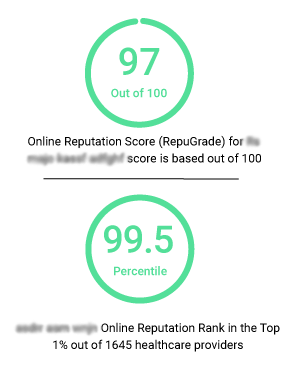Welcome to the First Research Findings of the Bi-Annual GMR Web Team Dental Patient Satisfaction Survey 2017 (January-June)
This survey measures the LOYALTY of patients for their dental offices and helps dentists understand the needs of their patient for developing efective patient related programs to address their pain points. This will help in developing a stronger bond between patient and physician and the patients will become the advocate of their physicians resulting in more Referrals fueling growth.
Key Takeaways from Primary Care Patient Survey:
- 89% of patients gave positive ratings about their visit to their dentists.
- 6% of patients rated their experience negative, whereas 5% rated their experience neutral.
- Overall, the Net Promoter Score, a measure of patient’s loyalty, for Dentists is 68* (Total Sample = 638)
-
- 81% of the Patients are Promoters - Loyal enthusiasts who will keep referring other patients
- 11% of the patients are Passives - Satisfied but NOT enthusiastic patients who are vulnerable to competitive offerings
- 7% of the Patients are Detractors - Unhappy patients who can damage the reputation of dentists and impede growth through negative word of mouth
Sentiment analysis of all patients’ comments about their experience suggested contentment among 88% and trust among 2% of all patients, consistent with their positive ratings.
Friendly, Professional, Recommended, and Love were the dominant words used by patients who rated their experience as positive.
Appointment, Insurance, and Cleaning were the dominant words used by patients rating their experience as negative.
Net Promoter Score* -- 68
** Net Promoter Score (a measure of Patient’s Loyalty) = % of Promoters - % of Detractors. Promoters are defined as % of patients who gave a rating of 9 or 10 to the dentist and Detractors are defined as % of patients who gave a rating between 0 and 6
Why the Dental Patient Satisfaction Benchmark Report?
Based on our experience of helping over 250 physicians since the inception of RepuGen in late 2016, we have noticed a fairly consistent Net Promoter Score of patients for their dentists. However, there is a lack of correlation between Net Promoter Score and dentists’ online reviews. This could be because unhappy patients are more likely to vent their frustrations online vs. satisfied patients post-ing about a positive experience online
There are four primary goals of this report:
- Develop a benchmark of patient’s loyalty for the entire Dental category.
- Help individual dental groups and dentists track their Net Promoter Score vs. the entire category.
- Identify patients’ pain points, develop programs to address these pain points, and track how these initiatives are impacting those pain points.
- Check online review scores to make sure it’s consistent with the average of the dentists used for this survey.
About the RepuGen Dental Patient Satisfaction Survey
- An online survey was conducted from January 2017 through June 2017 among 638 patients, belonging to a handful of dentists in the U.S. who are using the RepuGen service.
- The patients were asked to select their likelihood of recommending the dentist based on their latest experience on a scale of 0 to 10.
- Patients were asked to explain the reason behind their rating.
- All the information (rating score and comments) was detached from patient and doctor identification to make the report HIPAA compliant. RepuGen cannot backtrack comments or sentiments to link Net Promoter Score or sentiment to any patient or dentist.
- Patients were then classified into 3 categories – Promoters, Passives, and Detractors
-
- Promoters: Patients giving a rating of either 9 or 10 to their dentists were classified as Promoters. They are loyal enthusiasts who will keep referring the dentists to other patients.
- Passives: Patients giving a rating of 7 or 8 to their dentist were classified as Passive. They are satisfied but NOT enthusiastic patients who are vulnerable to competitive offerings.
- Detractors: Patients giving a rating of 0 to 6 to their dentist were classified as Detrac-tors. They are unhappy patients who can damage the reputation of their dentist and impede growth through negative word of mouth.
- All comments were grouped by positive, negative, and neutral ratings.
- An established 3rd party artificial intelligence tool was used to gauge patient sentiment by group (positive, negative, neutral) and also to gauge the intensity of the sentiment.
- RepuGen proprietary software was used to analyze word density of comments by group for all patients.
How Do Patients Rate Their Visit to Dentist Offices Based on Their RepuScore?
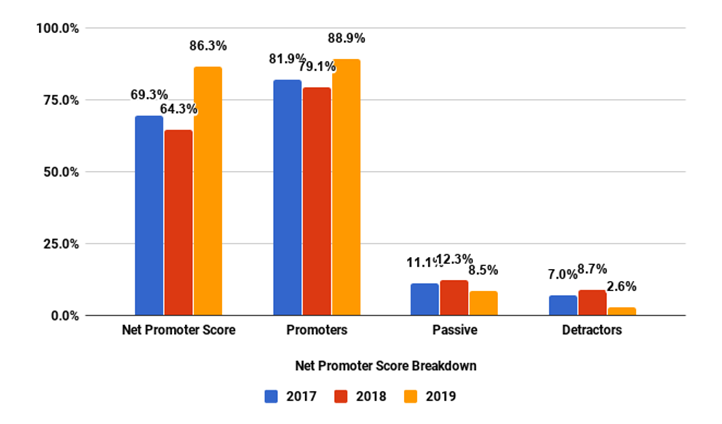
*Repuscore is the score given by patient on a scale of 0 to 10 when asked their likelihood of recommending the dentist based on their experience of the last visit. 0 means will not recommend and 10 means will recommend.
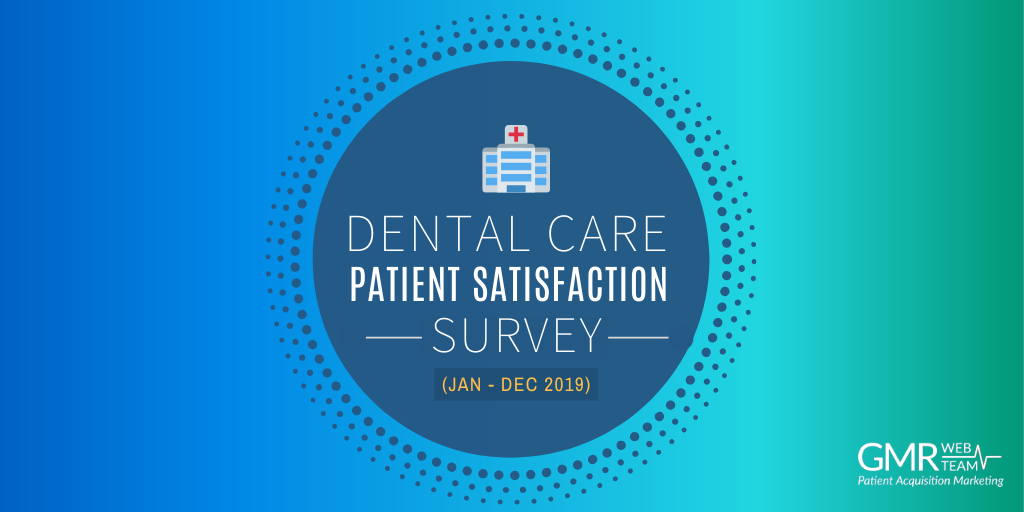
Net Promoter Score
Net Promoter Score* -- 68
- Promoters – 81%
- Passive – 11%
- Detractors – 7%
** The Net Promoter Score is an index ranging from -100 to 100 that measures the willingness of customers to recommend a company's products or services to others. It is used as a proxy for gauging the customer's overall satisfaction with a company's product or service and the customer's loyalty to the brand.
Key Findings:
- 89.43% of patients visiting dentists walk away with high positive feelings.
- 81% of these patients can potentially be promoters for dentists if the appropriate process is used.
- 18% of current patients are either very unhappy or NOT very enthusiastic about their current dentists and could leave them in the near future.
Analysis:
- This key measurement of patients’ satisfaction with their visit to dentists suggests a very high level satisfaction.
- However, up to 18% of their current patients are dissatisfied or could leave for another dentist.
- A net promoter score of 68 suggests the possibility of an opportunity for dentists and medical practices to use a referral program to acquire new patients from their existing patient base.
Patient Sentiment Analysis after their visit:
All Ratings - 6 months
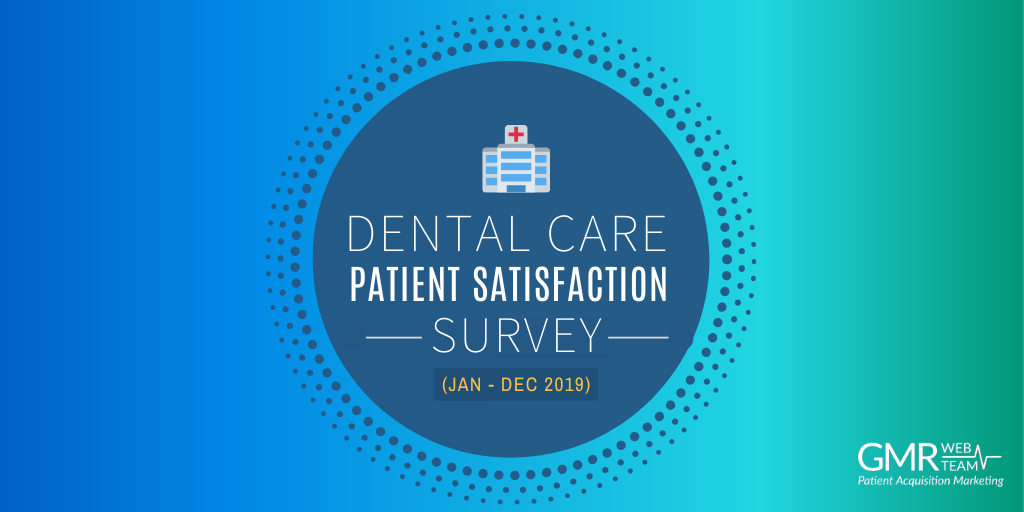
Patients are asked to explain their reason for rating their visit the way that they did. RepuGen analyzes sentiments based on the comments, using an artificial intelligence tool to understand their sentiments and the intensity of their sentiment.
Key Findings:
- 89% of patients left their dentist with a feeling of contentment.
- Only 44% of those exhibiting “content” emotion showed high intensity. This suggests room for dentists to improve their communication with patients and solidify their relationship with patients.
- Intensity of the majority of patients showing “trust” emotion was medium, thus leaving room for improvement on establishing trust between patients & dentists.
- Similar to “trust”, patients “anger” emotion intensity was medium; suggesting room for patient recovery by handling unhappy patients proactively.
Analysis:
While 89% of the patients are “content” with their dentist visit, the intensity of the emotion among the majority of patients is medium or low. Dentists and medical practices should con-sider instituting programs to increase patient satisfaction.
Given that 82% of “trust” emotion intensity is medium to low, dentists and practices should work on building higher trust.
Word Cloud Analysis
Word cloud analysis uses the frequency of words used by patients and picks up the most used words. Size of the word denotes frequency in the chart above.
Positive Ratings -- Top 20
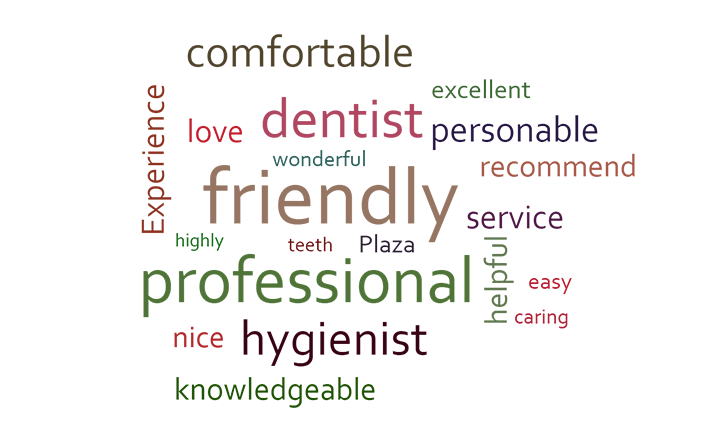
Key Findings:
- Friendly, Professional, Recommended, and Love were the most used words among patients who rated their visit between 9 and 10.
- Appointment, Explained, Personable, and Experience were some other frequently used words.
- Appointment was the only “negative” words among the top-20 most frequently used ones.
Analysis:
Frequently used words by satisfied patients should resonate with the happy patients, thus could be used to build the expectation for new patients. An example could be making a bold statement like “Friendly, Professional, Recommended, Love – These are the most used words our patients use to describe their visit”.
Negative Ratings – Top 20
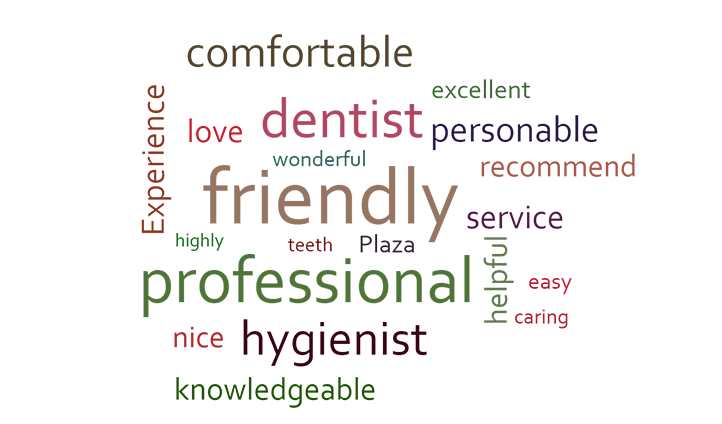
Key Findings:
- Appointment is the most frequently word used by unhappy patients.
- Insurance, Cleaning, and Scheduled are other negative words.
Analysis:
Frequently used words by unhappy patients allow the dentist to gauge patients’ reasons for dissatisfaction. However, given the fact that the comments of patients were de-identified, we can assume that appointments, insurance issues, and cleanliness of the office are some of the major concerns. These words are more relevant when linked to the patients (which individual account holders can do) and also when viewing the complete review of the patients.
Why is the Dental Patient Satisfaction Survey so important?
Online reviews and recommendations from existing patients are the best source of new patients for dentists. In-depth analyses of patient experience helps dentists identify their strengths and weaknesses, giving them the knowledge to make positive organizational changes.
Understanding the patient sentiment and its intensity provides insight into the patients’ mindsets after they leave the office. Dentists can use the information to improve satisfaction and brand their practice consistent with the positive sentiments generated by their service.
Density of words extracted from patient’s Net Promoter Score of different groups will help communicate the desired branding effort better.
Suggested Next Steps:
Dentists should gather patient experience information to better understand patient sentiment, and ultimately improve patient care and satisfaction.
Patient satisfaction data can also be used to attract more patients by:
- 81% of the Patients are Promoters - Loyal enthusiasts who will keep referring other patients
- 11% of the patients are Passives - Satisfied but NOT enthusiastic patients who are vulnerable to competitive offerings
Contact us at www.gmrwebteam.com to learn how you can start building your patient satisfaction data and how to use it to generate more patients.
Stay Up To Date on Marketing
News & Trends


